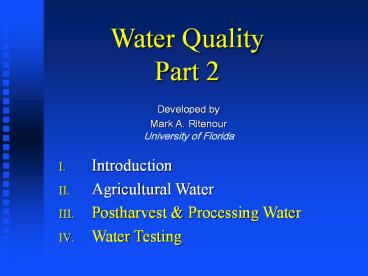Water Quality Part 2 PowerPoint PPT Presentation
1 / 26
Title: Water Quality Part 2
1
Water QualityPart 2
- Developed by
- Mark A. Ritenour
- University of Florida
- Introduction
- Agricultural Water
- Postharvest Processing Water
- Water Testing
2
Acknowledgements
- Some of the information and slides used in
preparing this presentation were provided by - FDA, Improving the Quality and Safety of Fresh
Fruits and Vegetables Training Curriculum.
(draft) - Trevor Suslow, Univ. Calif., Davis
3
II. Postharvest Processing Water
Singular critical control point capable of
amplifying an error in sanitation or hygiene
management
Suslow, UC Davis
4
Sources of Water to Monitor.
- Dump or soak tanks.
- Washing lines.
- Hydrocoolers.
- Infiltration into the commodity?
- Top ice liquid-ice injecting.
- Ice makers.
- Melting ice is messy.
- Anywhere Water Contacts Fruit!
5
The Problem with Water Handling Systems
- Produce from the field usually harbors many
pathogens (including dirty and decaying fruit). - Postharvest handling of fruits vegetables often
includes the use of flumes, dump tanks, spray
washers, or hydrocoolers. - Pathogens can quickly accumulate in these water
sources and contaminate healthy fruit.
6
Sanitation vs. Sterilization
- The application of chemical sanitizers can
destroy vegetative cells of bacterial pathogens
but may not be effective for the destruction of
the more resistant spores - Commercial sterility refers to the complete
elimination of pathogenic microorganisms,
including the spores of foodborne pathogens (i.e.
Clostridium botulinum). This can be achieved
through heat treatments such as canning but not
through the application of common disinfectants
7
Agents used to sanitize fruits and vegetables
- Chlorine
- Chlorine dioxide (Sanova, Oxine, etc.)
- Bromine iodine
- Hydrogen peroxide
- Peroxyacetic acid (Tsunami)
- Electrolyzed water
- Ozone
- UV-C illumination
8
Common Water Sanitizers
- Chlorine is by far the most widely used in fruit
vegetable packinghouses - Peroxyacetic acid commonly used in fresh-cut
operations - Less affected by organic load
- Ozone and UV used to some extent in fresh-cut
operations - More effective treating a stream of clear water
9
Benefits of Chlorination
- Relatively inexpensive (Cl2 least expensive)
- Can effectively reduce pathogen inoculum in dump
tanks, hydrocoolers, etc. - Reduces the transfer of decay organisms to
healthy fruit. - Can kill some existing pathogens on fruit
surfaces.
10
Sources of Chlorine
- Sodium hypochlorite (NaOCl)
- Liquid (5.25, 12.75, or 15)
- Calcium hypochlorite Ca(OCl)2
- Solid (65 or 68)
- Chlorine gas (Cl2)
- Gas cylinders
- Chlorine dioxide (ClO2)
- Generated on-site from sodium chlorite acid
11
Factors Affecting Chlorines Effectiveness
- Water pH (ClO2 least affected)
- Chlorine concentration
- Contact time
- Organic matter in the water
- Water temperature
- Type growth stage of pathogen
12
Water pH
- Hypochlorite and Cl2 form hypochlorous acid
(HOCl). - Hypochlorous acid is what kills pathogens.
NaOCl Ca(OCl)2 Cl2
gt
HOCl
13
High pH
- At high pH, hypochlorous acid converts to
hypochlorite ion (OCl-). - Hypochlorite ion is relatively ineffective
against pathogens.
HOCl
H OCl-
14
100
90
80
OC (32F)
70
20C (68F)
30C (86F)
60
Chlorine in Available Form
50
40
30
20
10
0
5
6
7
8
9
10
SOLUTION pH
15
Low pH
- At low pH, hypochlorous acid is quickly lost.
- Increased corrosiveness to equipment.
- Unpleasant working conditions due to increased
chlorine odor. - Recommended pH is between 6.5 7.5.
16
Chlorine Concentration
- Relatively low chlorine concentrations (lt 40
ppm) can kill pathogens. - Higher concentrations are commonly used to
compensate for various losses. - Recommendation 100 to 150 ppm free chlorine.
17
Contact Time
- Higher chlorine concentrations kill microbes
faster (e.g. lt 1 min). - Lower chlorine concentrations require longer
exposure time. - More resistant microbes or stages of growth may
require longer exposure times to kill.
18
Organic Matter in the Water
- Organic matter reacts with chlorine and quickly
reduces the amount of chlorine available to kill
microbes. - However, this chlorine may still be measured by
total chlorine testing kits.
19
Water Temperature
- At higher temperatures, available chlorine kills
microbes faster. - Higher temperatures also causes more rapid loss
of chlorine activity. - In practice, water temperature is usually
optimized for reasons other than optimized
chlorine effectiveness (e.g. rapid cooling).
20
Type and Growth Stage of Microbe
- Bacteria, and germinating fungal spores and
mycelia are relatively easy to kill with
chlorine. - Quiescent spores are much more resistant to
chlorine. - Microbes inside fruits and vegetables are
protected and will not be killed.
21
Chlorine Recommendations
- Maintain free chlorine levels between 100 to 150
parts per million. - Maintain pH between 6.5 and 7.5.
- Drain tanks often (e.g., daily) and refill with
clean water. - Use self-cleaning screens in dump tanks to remove
large debris and organic matter.
22
Maintaining Adequate Chlorination
- Manual monitoring and addition of chlorine.
- Requires frequent monitoring of chlorine
concentrations and pH. - Automated chlorine dispensing.
- Timed release or based on measured chlorine
concentrations or ORP. - With or without automatic pH adjustments.
23
Chlorine Test Kits
- Use kits that measure free chlorine levels
- Total chlorine kits can measure both free and
bound chlorine. - If sample dilution is required, dilute with
distilled water.
24
Chlorine Recommendations
- Check free chlorine levels often or use automated
systems. - Use all chemicals according to their labels.
- Consult local regulations for disposal of
chlorinated water.
25
Summary
- Maintain water free of decay causing organisms.
- Use potable water change daily.
- Wash particularly dirty commodities prior to
hydrocooling. - Use self-cleaning screens at pump intakes to
remove larger debris. - Design water handling equipment for easy
cleaning. - Use an approved sanitizer.
26
Thank you!

